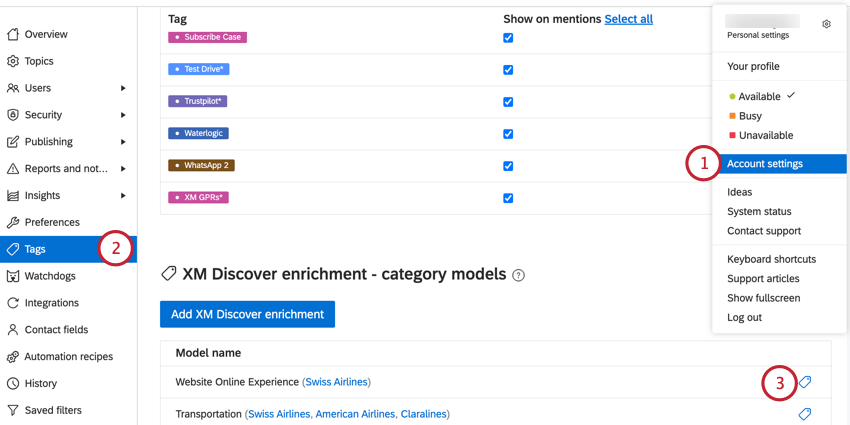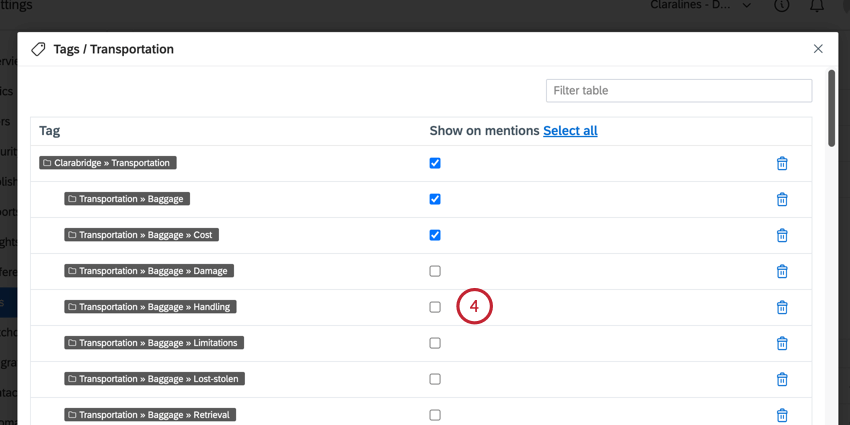Connecting Category Models to Topics
About Connecting Category Models to QSC Topics
Category models are standardized industry models designed by the XM Discover team to help you analyze your customers’ mentions. You can connect category models to your Social Connect topics to help categorize and tag new mentions based on the content of the mention.
Connecting to XM Discover
Before you can add category models to a topic, you must connect your Qualtrics Social Connect account with your XM Discover account.
- Navigate to Account settings.
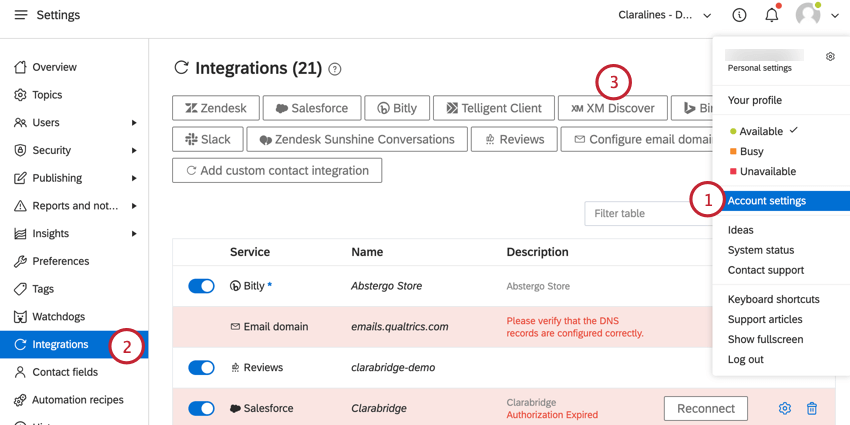
- Go to Integrations.
- Click XM Discover.
- Click Get Started.
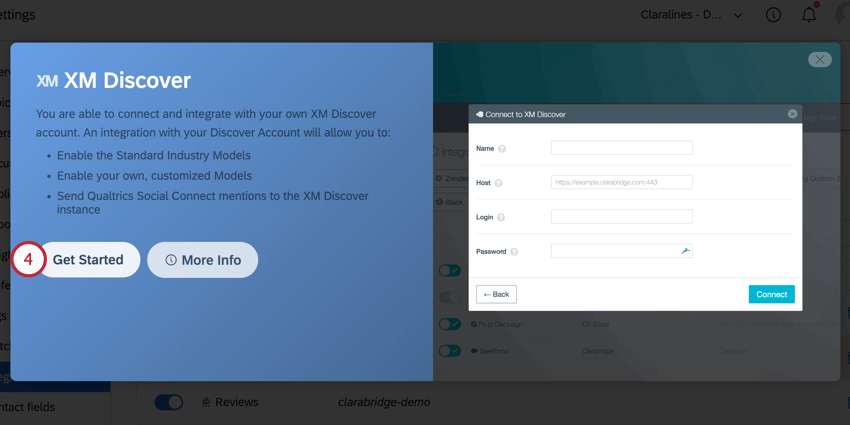
- Give the connection a name so you know what the connection is used for.
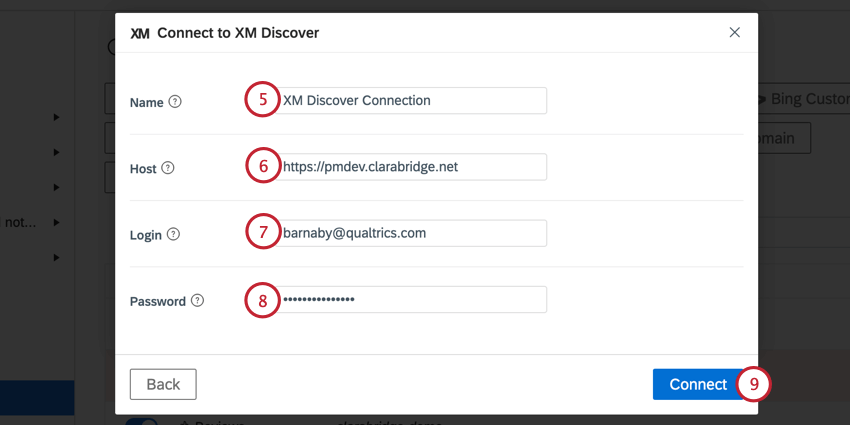
- Enter the host URL for your XM Discover account. You can find your host when logged in to Connectors or Designer in XM Discover by looking at your browser URL.
Example: If I’m logged into Designer and my URL is https://pmdev.clarabridge.net/cmp/projects, then my host URL is https://pmdev.clarabridge.net.
- Enter the login username of your XM Discover account.
- Enter the password for your XM Discover account.
- Click Connect.
Adding Category Models to a Topic
- Go to Account settings.
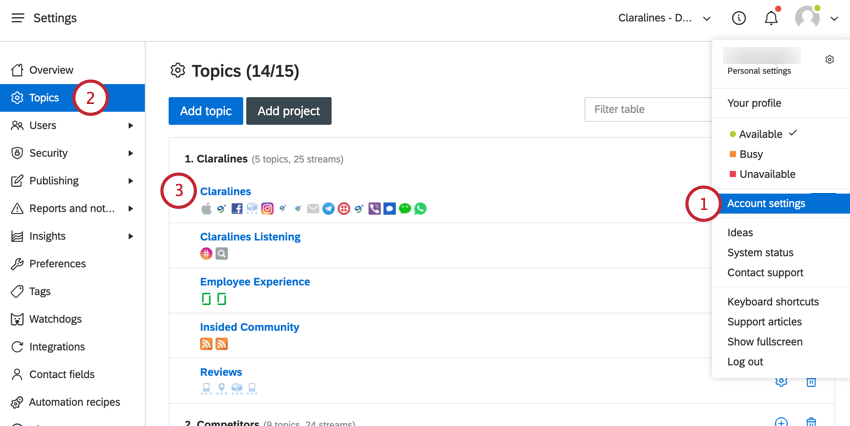
- Click on Topics.
- Select the topic you want to add category models to, or create a new topic.
- Click Connect to XM Discover.
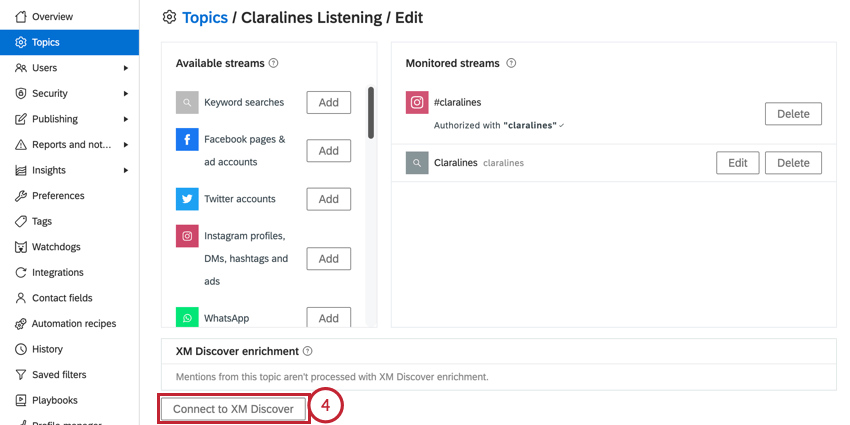
- Select Standard Industry Models.
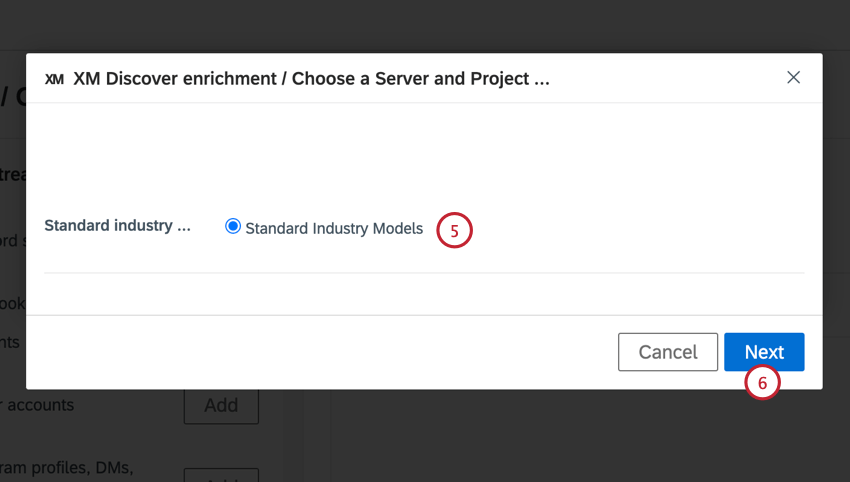
- Click Next.
- Choose the category models you want to include. You can add up to 10 category models in a topic. See Available Category Models for an overview of each model.
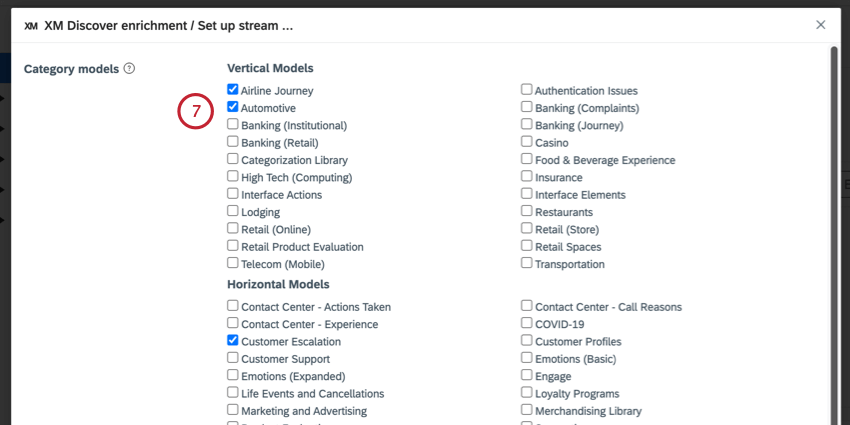
- Determine if you’d like Real-time enrichment. When enabled, mentions will be tagged with XM Discover category models when they are ingested in Social Connect. When disabled, mentions will be tagged after they are ingested.
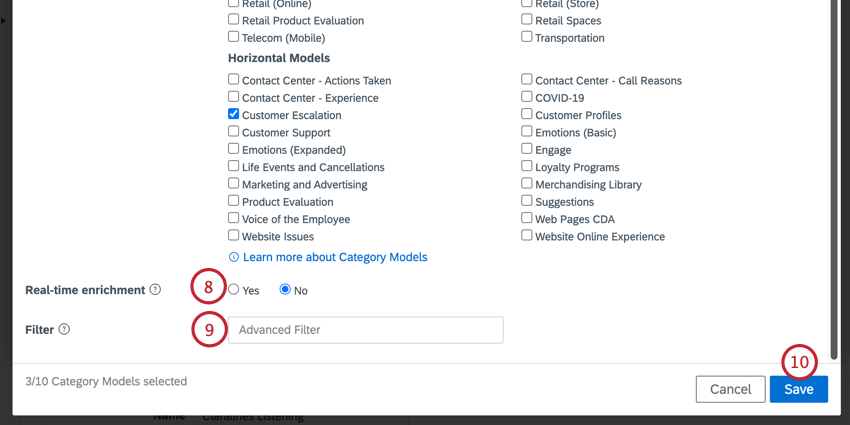
- If you’d like, apply a Filter. If you do not add a filter, then category model tags will be applied to all incoming mentions. If you add a filter, only mentions meeting the filter criteria will be tagged. See Filtering in Social Connect for more information on building filters.
- Click Save.
Hiding Category Model Tags from Mentions
By default, category model tags will be shown on mentions. However, if you have multiple active category models, a mention could be tagged with many category model tags, making it hard to see other tags you’ve added. You can disable category model tags from appearing on your mentions.
To hide your category model tags:
Available Category Models
This section covers the XM Discover category models that are available for tagging mentions in Social Connect. Models are broken into 2 different types:
- Horizontal: Horizontal models help you with analyzing feedback using different approaches. These models are useful across all industries.
- Vertical: Vertical models focus on the categorization of topics within a specific industry.
Keep reading for a description of each available category model.
Horizontal Models
- Contact Center – Actions Taken: Analyzes how agents interact with customers via a contact center (either via call or written communication). This model includes a list of actions that an agent may take in response to different client issues and situations such as transferring, apologizing, refunding, educating the customer, troubleshooting, reshipping orders and more.
- Contact Center – Call Reasons: Analyzes why customers reach out to your contact center (either via call or written communication). This model includes a two-level structure that categorizes common reasons for reaching out to a contact center including account management, billing, delivery information, website issues and more
- Contact Center – Experience: Analyzes the environmental factors that may affect the customer’s or agent’s experience when communicating on the phone or via written communication. This model includes categories to track call quality, communication clarity, hold experience, IVR journey, and post-call interactions such as surveys and promotions.
- COVID-19: Analyzes all anticipated topics associated with COVID-19 for retail, hospitality, travel, banking, healthcare, and insurance verticals.
- Customer Escalation: Identifies customers who require assistance or who are a threat to your organization.
- Customer Profiles: Defines demographic groups. The model looks for specific keywords and phrases to identify individuals with specific interest, ages, genders, ethnicities, etc.
- Customer Support: Analyzes the experiences of your customers when contacting customer support. It will automatically categorize mentions based on the agent’s competences, phone quality and the ability to solve a problem.
- Emotions (Basic): Defines 10 distinct emotions that are frequently expressed in customer feedback.
- Emotions (Expanded): Expands upon the Emotions (Basic) model by extending to nearly 50 distinct emotions. These emotions are organized into 2 tiers so that you can analyze emotions on a broad level and then drill-down into more specific emotional states.
- Engage: Groups customers into “Act,” “Investigate,” or “Reward” buckets based on their comments about their brand experiences. It also features distinct categories for various threats such as complaints to the BBB or OSHA.
- Life Events and Cancellations: Outlines federal policies for when a customer cancels a policy. This model is best used with data from the healthcare industry, but can be used with various types of subscription-based programs as well.
- Loyalty Programs: Focuses on the key aspects of a rewards program. This model offers a wide range of topics about enrollment, rewards, and loyalty programs.
- Marketing and Advertising: Analyze the marketing efforts of a brand or organization. The model classifies the advertising, pricing and collateral by channel, product or even by a specific campaign. For example, feedback on your brand new radio and tv commercial can be tagged automatically thanks to this model.
- Merchandising Library: Organizes all common products in a generic retail store (such as a big box or grocery store) into a three tier hierarchy. Each topic isolates a specific product group such as fresh fruit, hand tools, women’s apparel, and everything in between.
- Product Evaluation: Examines the features of a product and its packaging which could potentially cause issues for a customer. It also includes topics relating to safety and legal aspects which could be cause for escalation.
- Suggestions: Identifies feedback in which customers are making suggestions about your products, prices, staff, etc.
- Voice of the Employee: Analyzes employee feedback for common topics that affect the employee’s experience when at work.
- Web Pages CDA: Provides contextual background for any virtual environment when related to web pages like the login, home, ‘contact us’ pages.
- Website Issues: Identifies the issues and errors that your customers face on your website or app.
- Website Online Experience: Helps structure data when customers give feedback about your website. The classification is based on the successes and failures of your website.
Vertical Models
- Airline Journey: Analyzes all aspects of the customer journey related to an airline. It starts with the process of booking a ticket, the time up to the flight, the airport experience, airline club experiences, rewards programs, customer service, and contact center information.
- Authentication Issues: Enables you to understand the barriers that users might face when trying to log in to your website or application.
- Automotive: Provides you a comprehensive view of the car buying experience. This model focuses on categorizing experiences at the corporate and dealership levels. Additionally, you’ll find detailed categorization tags around a vehicle’s features and the car service experience.
- Banking (Complaints): Provides insight to common issues that occur within a customer’s experience with a bank or financial institution. This model includes topics related to account management, improper communication, fees, fraud, military benefits, and more.
- Banking (Institutional): Analyzes the customer’s journey through the banking lifecycle. Includes tags based on account types, banking services, policies, and online banking.
- Banking (Journey): Outlines each aspect of a customer journey with a bank. This model offers topics within the branch, ATM, digital, and contact center spheres, and helps to understand different pain points within the journey.
- Banking (Retail) Provides insights into the banking experience from a customer’s perspective. This model includes tags such as investments, insurances, and planning services.
- Casino: Provides a comprehensive view of the gambling experience within a casino. This model includes coverage of games, food and beverage, personnel, and the casino environment.
- Categorization Library: Contains a variety of useful topics that can be used in various industries and use cases. Categories are extremely diverse and include topics varying from sushi to wait times to fraud.
- Food & Beverage Experience: Provide a robust view of a customer’s interaction with a food or beverage product. It includes tags on topics about advertising, packaging, quality, adverse reactions, and more.
- High Tech (Computing): Focuses on specific technological products such as monitors, printers, and operating systems. Next to these specific products, this model will also tag information on orders, delivery, and payment.
- Insurance: Provides comprehensive coverage of the customer journey with an insurance agency including the quote, claim, and fulfillment processes. This model also includes topics regarding general customer service, website, policies, and services.
- Interface Actions: Captures all action-related components of the customer’s experience when interacting with your software interface. This model includes a list related to click types, zoom features, shortcuts, and more.
- Interface Elements: Provides contextual insights for any elements found in a web space, app, or product interface. This model will help you identify aspects of your interface that users find notable.
- Lodging: Includes a representation of the customer’s touch points during their stay at a hotel. This model breaks out different roles, amenities, spaces, and programs that may affect a customer’s perception of their stay.
- Restaurants: Maps out the customer’s journey when visiting a restaurant. This model tags mentions with topics about quality, experience, location, employees, marketing, payment and more.
- Retail (Online): Examines a customer’s experience while making purchases online. This model tags topics based on fulfillment, website functionality, account manager interactions, and corporate initiatives that may affect a customer’s satisfaction.
- Retail (Store): Examines a customer’s experience visiting and making purchases in a brick and mortar store. This model focuses on the physical qualities of the store, the employees, and the checkout experience.
- Retail Product Evaluation: Examines the features of a product and its packaging which could potentially cause issues for a customer. This model also includes topics related to safety and legal aspects which could be a cause for escalation.
- Retail Spaces: Provides a mechanism for retail businesses to examine the features of their stores that customers find notable. It breaks down the physical spaces (i.e. parking lots, fitting rooms, restrooms, etc.), specific departments, and in-store services (such as pharmacies, ATMs, opticians, etc.). Often, this model is paired with the Retail (Store) model to get a full picture of the customer journey in the physical store.
- Telecom (Mobile): Maps out the customer journey with a telecommunications company. Breaks-out account maintenance, billing, products, support channels, and contract plans.
- Transportation: Represents the customer’s full experience while traveling. Topics include the check-in process, food, entertainment, and legal challenges.
